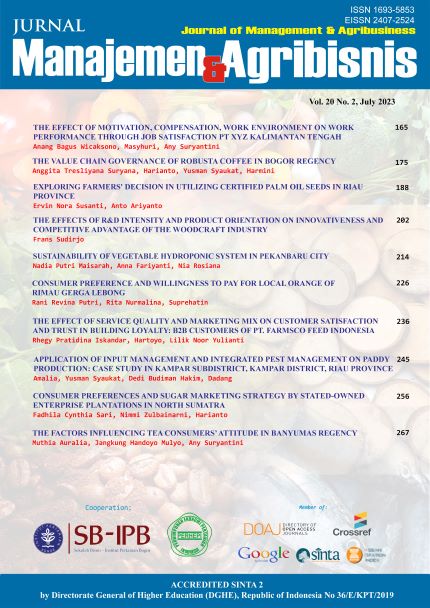Consumer Preferences and Sugar Marketing Strategy By Stated-Owned Enterprise Plantations in North Sumatra
Abstract
Sugar is a commodity that recreates a valuable role in the daily consumption of Indonesian. This study aims to determine the attributes and combinations that influence consumer preferences in buying branded white crystal sugar and the marketing strategies that can be applied in marketing Walini sugar at PT. Perkebunan Nusantara II. Analysis of consumer preferences in this study using the conjoint analysis method. Meanwhile, the marketing strategy analysis uses the A'WOT method. Based on the conjoint analysis results, it was concluded that the most important attribute in evaluating consumers' interest in branded white crystal sugar is color. Subsequently, the best combinations of attributes that consumers favored were obtained, namely white color, selling points in minimarkets, sales promotions in the form of discounts/coupons/gifts, vibrant and attractive packaging, slight sugar texture, and sugarcane's aroma. Furthermore, based on the results of the A'WOT analysis, seven alternative marketing strategies were obtained. The priority strategy with the highest weighted value is expanding the cooperation network with potential distributor agents.
Keywords: A’WOT, conjoint analysis, consumer preference, marketing strategy, white crystal sugar
Authors
Authors who publish with this journal agree to the following terms:
- Authors retain copyright and grant the journal right of first publication with the work simultaneously licensed under a Creative Commons Attribution License that allows others to share the work with an acknowledgement of the work's authorship and initial publication in this journal.
- Authors are able to enter into separate, additional contractual arrangements for the non-exclusive distribution of the journal's published version of the work (e.g., post it to an institutional repository or publish it in a book), with an acknowledgement of its initial publication in this journal.
- Authors are permitted and encouraged to post their work online (e.g., in institutional repositories or on their website) prior to and during the submission process, as it can lead to productive exchanges, as well as earlier and greater citation of published work (See The Effect of Open Access).

